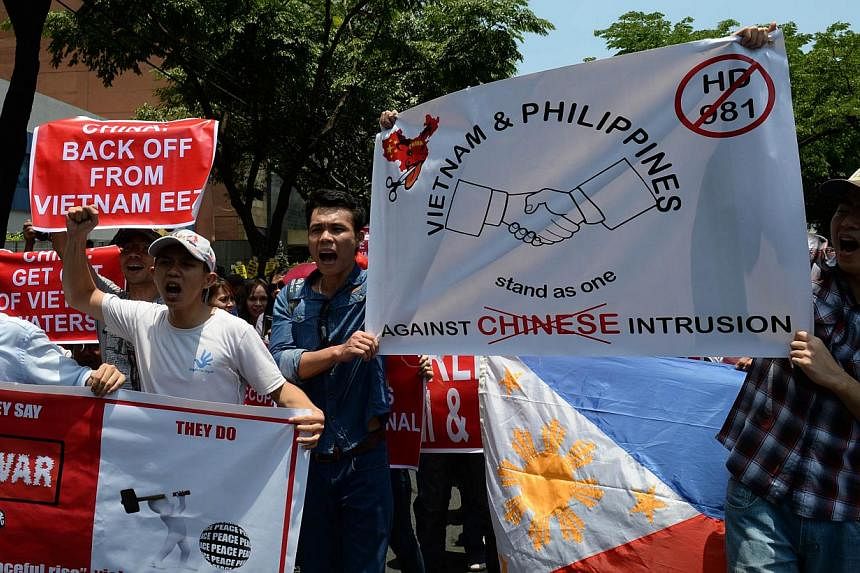Despite all the publicity about the tension between China and Vietnam over the presence of a Chinese oil rig in waters near the disputed Paracel Islands, it is the Chinese- Philippine relationship that could more easily spiral out of control.
The reason is simple: There is little to hold back a sharp deterioration in Chinese-Philippine relations. And US involvement is encouraging China to believe it should establish a clear "red line" when it comes to the South China Sea disputes.
Anti-China demonstrations in Vietnam led to attacks on foreign industries with Chinese character signs, owned by Chinese (including Taiwanese), Singaporean and South Korean manufacturers.
Understandably, domestic considerations may have influenced the decisions of both the Chinese and the Vietnamese governments during the recent diplomatic row. However, precisely because this conflict is domestic-oriented, leaders in both countries know where and how to control the situation.
The Vietnamese government clamped down on the anti-China protests on May 18. China's official media has also asked the Chinese people to trust the Party to resolve the problem.
However, in the case of the Philippines, the Chinese and Philippine politicians appear to be playing a different game that involves external players as well as domestic nationalist forces. This makes the conflict relatively harder to control or predict. The lack of private information or channels has further complicated the problem, creating the possibility of missed signals and misunderstandings.
After the March exchanges between China and the Philippines over the Second Thomas Shoal (Reni Reef in Chinese), the Philippines submitted a case against China's nine-dash line and other aspects of China's South China Sea claims to an arbitration tribunal at The Hague.
In April, US President Barack Obama visited Asia (Japan, the Philippines, Malaysia and South Korea, three of which are US allies), and American troops carried out joint military exercises with the Philippines.
This month, 11 Chinese fishermen were arrested by the Philippines allegedly for catching endangered turtles while in disputed waters.
The Chinese government claimed that the sequence of events reflected US support behind the scenes, thus boosting Manila's confidence in provoking Beijing in the South China Sea.
Chinese Foreign Minister Wang Yi, therefore, "urged the US to treat these issues with objectivity and fairness, live up to its commitment, watch its words and actions, and avoid emboldening relevant parties' provocative actions".
President Obama's visit to South-east Asia reassured US allies and friends by confirming Washington's strategic commitments in the region.
Consequently, China has become the target of US strategic manoeuvres, although Mr Obama tried to downplay their "containment" purpose by calling China "a critical country to the region and the world".
For Chinese policymakers, China's rise is a bargaining process involving China and the outside world, especially the US. Given the US pivot or rebalancing towards Asia, China has no choice but to show its own resolve in order to negotiate new terms with Washington in the region. Strategically, China needs to choose carefully where it should use limited and controlled escalations, in order to send a warning against unscrupulous behaviour by some states.
China's official newspaper - the People's Daily - has mentioned the need for China to set a red line in the South China Sea. Now it is time for Chinese leaders to calculate carefully and bargain cautiously with the United States, making its bottom line clear and what the consequences might be if it is ignored.
Given the close ties between the US and the Philippines, the Philippines and the South China Sea is the logical place for China to test US commitments as well as showcase China's resolve. China's Chief of the People's Liberation Army (PLA) General Staff Fang Fenghui sent a clear message during his visit to the US this month: The Chinese military is ready to back words with action.
Historically, the PLA has waged limited wars in order to "teach lessons" to its neighbours. This was certainly the case in the 1962 Sino-Indian war and the 1979 Sino-Vietnam conflict. Now, more than 30 years later, the PLA is more confident. It is also more modern. That said, China also has a stake in maintaining regional stability to ensure the continuation of its own economic development.
So far, China has refrained from using force in the South China Sea. However, various incidents in the area have disturbed China's relations with its neighbours in recent years. In the eyes of Chinese policymakers, this is a direct result, or at least a side effect of the US policy of rebalancing towards Asia. The Philippine government's "provocation" in the South China Sea is seen as action by a US pawn testing China's resolve. China therefore feels it must respond.
Asean has a role to play here. Historically, its quiet diplomacy has been the preferred diplomatic channel to de-escalate crises.
The recent closing statement from the Asean summit did not mention China by name, but called for restraint by all parties. As Asean as an organisation is not involved in the territorial disputes in the South China Sea, any attempt to blame Beijing would only have made the situation worse.
China intends to maintain its friendly relationship with Asean, particularly given its strong economic ties with the grouping.
China can therefore be expected to pay serious attention to Asean mediation so long as its quiet approach to diplomacy remains within China's comfort zone. Asean can mediate between China and the Philippines by delivering both credible "private information" about each other's intentions.
China will continue to jostle with the US for a new power position and a higher status in the Asia Pacific. Asean can help ensure that this struggle between giants does not get out of hand.
The writer is Associate Professor of Political Science at Utah State University and a visiting senior fellow in the China Programme at the S. Rajaratnam School of International Studies (RSIS).

